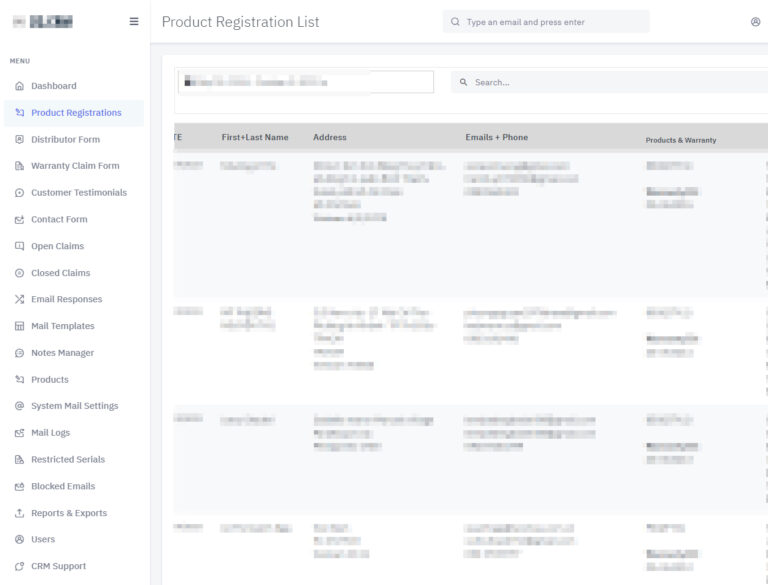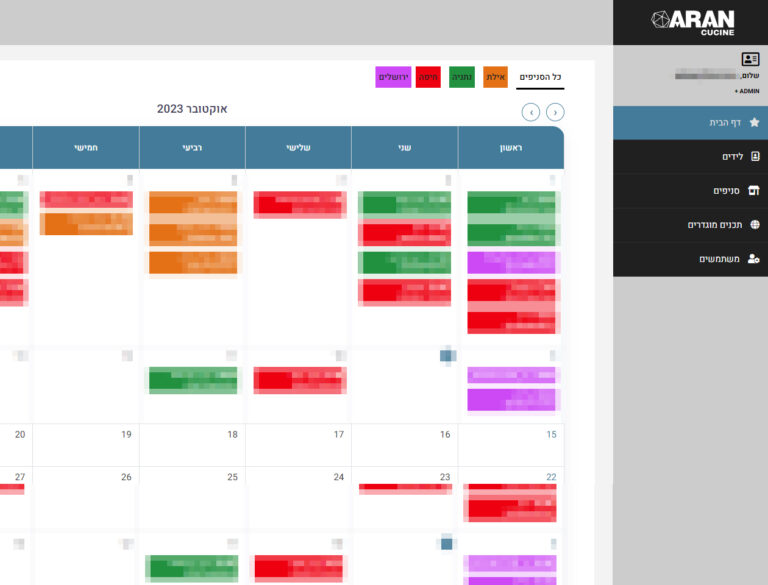Are you looking to build some cool web applications? Well, you’re in luck because I’m here to tell you all about API and REST API development in PHP! APIs, or Application Programming Interfaces, allow different software applications to communicate with each other. And REST APIs are a type of API that uses HTTP methods like GET, POST, PUT, and DELETE to perform operations on resources. PHP is a popular programming language for web development, and it’s great for building APIs too. With PHP, you can create endpoints that can be accessed by other applications, allowing you to retrieve and manipulate data easily. So, if you’re ready to dive into the world of API development, PHP is a fantastic choice to get started with. Let’s build something awesome together!
projects and details with api development
Multifunctional CRM

CodeIgniter CRM with full control on autoations and users
Laravel web portal with SEO++

Performance and SEO optimization + API integrations
Affiliate shop

Aliexpress affiliate API + custom CMS in Woocommerce
CRM – Leads

Custom CRM with SMS API and automated scenarios
In today’s rapidly evolving digital landscape, APIs have emerged as the backbone of modern technology, enabling seamless communication and integration between different software systems. API development has become an essential skill for software engineers and developers, allowing them to create powerful and dynamic applications that can connect to a wide range of services and platforms. With the rise of cloud computing and the Internet of Things, the demand for well-designed APIs has never been higher, making it a crucial area of expertise for those looking to stay ahead in the tech industry. Building APIs is not just about connecting different pieces of software, it’s about unlocking endless possibilities and opening doors to innovation. By crafting intuitive and robust APIs, developers can empower their creations to interact with a diverse array of tools and services, unleashing the full potential of their applications. As we continue to push the boundaries of what is possible in the digital realm, mastering the art of API development is the key to unlocking new opportunities and driving progress in technology. Explore the world of API development and embark on a journey of creativity and connectivity that will shape the future of software development.
Steps to Creating a Custom API for Your Website Best Practices for API Development Leveraging APIs to Enhance User Experience Future Trends in API Development Integrating APIs in Web Development
Steps to Creating a Custom API for Your Website
Creating a custom API for your website is an exciting and rewarding endeavor that can expand the capabilities of your site and enhance the overall user experience. By developing your own API, you have the freedom to tailor it to your specific needs and requirements, ensuring that it aligns perfectly with your brand and vision. The first step in creating a custom API is to identify the purpose and goals of your API. Consider what functionality you want to enable on your website and how an API can help you achieve those objectives. Whether you want to enhance the performance of your site, streamline processes, or provide new features to your users, having a clear understanding of your goals will guide you in designing an API that meets your needs. Once you have defined the purpose of your API, the next step is to outline the functionality and endpoints that you want to include. Take the time to carefully consider the data and resources that you want to make available through your API, ensuring that they are relevant and useful to your users. By identifying the key endpoints and specifying the data that will be returned, you can create an API that is efficient, user-friendly, and in line with your goals. After defining the functionality and endpoints of your API, the next step is to design the structure and architecture of your API. Consider how you want to organize your endpoints, how data will be retrieved and manipulated, and how requests will be processed and responded to. By designing a logical and intuitive structure for your API, you can ensure that it is easy to use and understand, both for developers who will be integrating it into their applications and for end users who will be interacting with it. Once you have designed the structure of your API, the next step is to develop the API itself. This involves writing the code that will power your API, implementing the functionality and endpoints that you have defined, and ensuring that everything works seamlessly together. Take the time to test and debug your API thoroughly, checking for any errors or issues that may arise and making any necessary adjustments to ensure that it functions as intended. After developing your API, the final step is to document and promote it. Create comprehensive documentation that outlines the functionality, endpoints, and usage of your API, making it easy for developers to integrate it into their applications. Promote your API through your website, social media channels, and other marketing channels, highlighting the value it can provide to users and encouraging developers to take advantage of it. In conclusion, creating a custom API for your website is a challenging but rewarding process that can unlock new possibilities for your site and enhance the overall user experience. By following these steps and taking the time to design, develop, and promote your API, you can create a powerful tool that aligns with your goals and helps you achieve success.
Best Practices for API Development
API Development is a crucial aspect of modern software development, enabling seamless communication between various applications and systems. In order to create robust and reliable APIs, it is essential to follow best practices that not only ensure functionality but also promote scalability and maintainability. One of the most important principles to keep in mind during API development is to design APIs with the end-users in mind. This means understanding the requirements and expectations of the consumers who will be using the API and creating endpoints that are intuitive and easy to use. By keeping the user experience at the forefront of development, you can ensure that your API is accessible and efficient for those who rely on it. Another key best practice for API development is to prioritize consistency and standardization. By establishing clear naming conventions, error handling procedures, and response formats, you can make it easier for developers to interact with your API and reduce the potential for confusion or errors. Consistent APIs are not only easier to work with but also promote a sense of trust and reliability among users. When developing APIs, it is also important to pay close attention to security considerations. By implementing proper authentication and authorization mechanisms, encrypting sensitive data, and regularly testing for vulnerabilities, you can protect both your API and the data it processes from potential threats. Building security features into your API from the outset can help prevent costly breaches and safeguard the integrity of your applications. Scalability is another important aspect to consider when developing APIs, particularly in today’s rapidly evolving technological landscape. By designing APIs that are flexible and adaptable to changing requirements, you can ensure that your applications can grow and evolve without sacrificing performance or stability. Planning for scalability from the beginning can save time and resources down the line, allowing your APIs to accommodate increasing demand and usage seamlessly. In addition to scalability, maintainability is another key consideration for API development. By structuring your code in a clear and organized manner, documenting your endpoints and functions thoroughly, and implementing versioning strategies, you can simplify the process of maintaining and updating your APIs over time. Well-maintained APIs are not only easier to work with but also promote a culture of continuous improvement and innovation within your development team. Lastly, testing is an essential part of API development that should not be overlooked. By writing automated tests for your endpoints, validating input data, and monitoring performance metrics, you can identify and address issues before they impact users. Thorough testing ensures that your APIs are stable, reliable, and performant, allowing you to deliver a high-quality experience to your consumers. In conclusion, following best practices for API development is crucial for creating APIs that are not only functional and reliable but also scalable, maintainable, and secure. By designing with the end-users in mind, prioritizing consistency and standardization, focusing on security, planning for scalability and maintainability, and conducting thorough testing, you can build APIs that drive innovation, facilitate seamless integration, and create value for both developers and consumers alike.
Leveraging APIs to Enhance User Experience
In today’s fast-paced digital world, user experience is paramount. Consumers are looking for seamless, intuitive, and personalized interactions with their favorite apps and websites. This is where APIs come in. APIs, or Application Programming Interfaces, are the backbone of modern software development. They allow different software systems to communicate with each other and share data and functionality. By leveraging APIs, developers can create richer, more robust applications that offer enhanced user experiences. One way APIs enhance user experience is by enabling smooth integrations between different systems. For example, consider a travel booking app that integrates with a weather API to provide real-time weather information for the user’s destination. This integration not only enhances the user’s travel planning experience but also adds value and convenience. APIs also allow developers to tap into a vast ecosystem of third-party services and data sources. By integrating with popular APIs such as Google Maps, PayPal, or Facebook, developers can enhance their applications with features that would be too time-consuming or costly to build from scratch. This not only saves time and resources for the development team but also provides users with more robust and feature-rich applications. In addition to improving functionality, APIs can also enhance user experience by enabling personalization. By leveraging APIs that provide user data, developers can create personalized experiences based on individual preferences, behaviors, and demographics. For example, a music streaming service can use APIs to recommend songs based on a user’s listening history, ensuring a more tailored and engaging experience. Furthermore, APIs can streamline user interactions and workflows by automating repetitive tasks. For instance, an e-commerce platform can integrate with a payment gateway API to enable seamless and secure online payments, reducing friction and improving the overall user experience. By automating processes through APIs, developers can create more efficient and user-friendly applications. Beyond functionality and personalization, APIs can also enhance user experience by increasing the speed and performance of applications. By offloading certain processes to external APIs, developers can lighten the load on their servers and improve response times for users. This can lead to faster page load times, smoother animations, and overall better performance, all of which contribute to a more satisfying and enjoyable user experience. Ultimately, leveraging APIs to enhance user experience is not just about adding bells and whistles to an application. It’s about creating meaningful and impactful interactions that make users’ lives easier, more enjoyable, and more productive. By tapping into the power of APIs, developers can craft experiences that are not only functional and efficient but also delightful and memorable. As we continue to push the boundaries of what is possible in software development, APIs will play an increasingly important role in shaping the user experiences of tomorrow. By embracing APIs and leveraging their capabilities to their fullest potential, developers can create applications that are not only technologically advanced but also deeply human-centered and user-focused. So let’s harness the power of APIs to elevate our user experiences and create a brighter, more connected digital future.
Future Trends in API Development
The world of technology is constantly evolving, and API development is no exception. As we look towards the future, there are several exciting trends that are likely to shape the way APIs are created and utilized in the years to come. One major trend that we can expect to see in API development is the rise of GraphQL. GraphQL is a query language for APIs that allows developers to request only the specific data that they need, rather than being forced to download the entire dataset. This not only streamlines the development process, but also helps to optimize performance and improve user experience. As more and more companies begin to adopt GraphQL, we can expect to see a shift away from traditional REST APIs towards this more efficient and flexible approach. Another trend that is likely to have a significant impact on API development is the increasing focus on security. With data breaches and cyber attacks becoming increasingly common, it is more important than ever for developers to prioritize security in their APIs. We can expect to see the development of new security protocols and standards that will help to protect sensitive data and mitigate potential risks. Additionally, companies may begin to invest more heavily in implementing security measures such as encryption, authentication, and access control to ensure the integrity of their APIs. Artificial intelligence and machine learning are also likely to play a key role in the future of API development. These technologies have the potential to revolutionize the way that APIs are created and utilized, by enabling developers to build more intelligent and responsive applications. For example, AI-powered APIs could help to automate tasks, make real-time predictions, and provide personalized recommendations to users. As AI and machine learning continue to advance, we can expect to see a growing number of APIs that leverage these technologies to deliver more dynamic and intelligent user experiences. The Internet of Things (IoT) is another trend that is reshaping the landscape of API development. As more and more devices become connected to the internet, the demand for APIs that can facilitate communication between these devices is on the rise. APIs that can collect, analyze, and share data from IoT devices will be crucial for enabling the seamless integration of smart devices into our daily lives. We can expect to see a proliferation of IoT-specific APIs that will enable developers to build innovative and interconnected applications that leverage the power of the IoT. In conclusion, the future of API development is bright and full of exciting possibilities. From the adoption of GraphQL and the focus on security to the integration of AI, machine learning, and IoT technologies, there are numerous trends that are likely to shape the way APIs are created and utilized in the years to come. As developers, it is important for us to stay informed about these trends and be proactive in adapting our practices to meet the evolving needs of the industry. By embracing these trends and leveraging the latest advancements in technology, we can unlock new opportunities and create innovative solutions that push the boundaries of what is possible with APIs.
Integrating APIs in Web Development
APIs are the foundation of modern web development, allowing different software systems to communicate and work together seamlessly. Integrating APIs in web development opens up a world of possibilities and can greatly enhance the functionality and user experience of a website or web application. When you integrate APIs into your web development projects, you are essentially tapping into a vast network of resources and services that can elevate your website to the next level. Whether you need to access real-time data, process payments, or add social media functionality, there is an API out there that can help you achieve your goals. One of the key benefits of integrating APIs in web development is the ability to streamline processes and automate tasks. Instead of reinventing the wheel and writing code from scratch, you can leverage existing APIs to handle complex functions with just a few lines of code. This not only saves time and effort but also ensures that your website is reliable, efficient, and secure. Furthermore, integrating APIs allows you to easily expand the capabilities of your website without having to build everything yourself. Want to add a map to your contact page? There’s an API for that. Need to implement a weather widget on your homepage? There’s an API for that too. By incorporating third-party APIs into your web development projects, you can quickly add new features and functionalities that would otherwise be time-consuming and costly to develop. In addition to enhancing the functionality of your website, integrating APIs can also improve the user experience. By using APIs to access data and services from reputable sources, you can provide users with up-to-date information and personalized content that keeps them engaged and coming back for more. Whether you are building an e-commerce site, a social networking platform, or a news aggregator, integrating APIs can help you create a more dynamic and interactive user experience. Moreover, integrating APIs in web development allows you to future-proof your projects and adapt to changing technologies and trends. As new APIs are developed and existing ones are updated, you can easily swap out outdated functionality and incorporate the latest features into your website. This flexibility ensures that your website remains competitive and relevant in a rapidly evolving digital landscape. When it comes to integrating APIs in web development, the possibilities are truly endless. Whether you are a seasoned developer or just starting out, incorporating APIs into your projects can unlock a world of opportunities and take your websites to new heights. From improving efficiency and automation to enhancing functionality and user experience, APIs are the secret ingredient that can transform your web development projects from good to great. So why wait? Start exploring the world of APIs today and discover how integrating them into your web development projects can revolutionize the way you build websites and web applications. With the power of APIs at your fingertips, the sky’s the limit for what you can achieve.
As we have seen, API development is a crucial aspect of modern technology that has the power to transform the way we interact with and build applications. By constantly pushing the boundaries of innovation and creativity, we have the ability to create seamless and efficient experiences for users around the world. Let us continue to strive for excellence in API development and unlock the endless possibilities that lie ahead. Remember, with dedication, passion, and a relentless pursuit of improvement, we can shape the future of technology and make a positive impact on the world. So, let us embark on this journey together, embracing the challenges and opportunities that come our way, and dream big as we strive to create a better, more connected world through the power of APIs.
